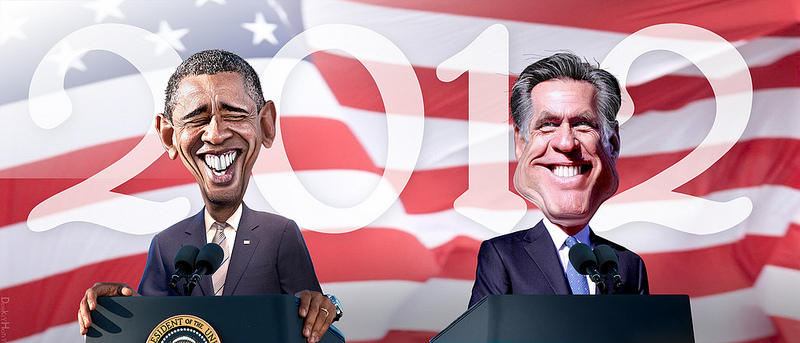by Cameron Hill ’15
After a presidential election season ridden with memorable, often hysterical moments (Clint Eastwood’s now famous soliloquy to an empty chair comes to mind), and an extremely close race, Barack Obama was reelected President of the United States on Tuesday November 6, 2012. He defeated the Republican nominee, the former governor of Massachusetts, Mitt Romney and his running mate Paul Ryan. Going into Tuesday, many analysts expected days of ballot recounts and lawsuits. It was even suggested that neither candidate would be able to reach the total of 270 electorate votes needed to secure an election.
However, it quickly became apparent that Obama was the likely victor. According to CNN, Romney would have needed the electoral votes of battleground states Virginia, Ohio, and Florida, along with those of the traditionally red states he was likely to win, to obtain a victory. All three of those states were eventually won by Obama.
The economy was one of the central issues of this campaign. Romney ran on a policy of lowering taxes for all Americans and for businesses in order to stimulate economic growth. He would have combined these tax cuts with cuts to domestic spending; for example, he mentioned cutting funding to PBS. Obama’s economic platform includes plans for tax increases on people earning more than 250,000 dollars per year as well as government spending cuts in an attempt to balance the nation’s budget.
Another main issue of this campaign was the topic of government subsidized federal health care in a program colloquially termed “Obamacare.” This program, signed into law in March 2010, will eventually require every American to have health insurance. Although Mitt Romney instituted a similar program in Massachusetts when he was governor, he vehemently opposed a federal health care plan. Republican policy, ever in favor of federal government with a lesser impact on the day to day lives of citizens, holds that mandates regarding health care should be determined on a state by state basis, if regulation is required at all.
Through the entire campaign season polls showed the two candidates in a virtual deadlock, especially after Governor Romney’s undisputed success in the first presidential debate. His dominance in this debate gave momentum to his campaign and made many analysts rethink their predictions. President Obama’s strong performance in the following two debates, however, took away some of the wind in the Governor’s sails.
When Election Day came, a deciding factor in Obama’s win was his success with women voters. Women made up fifty-three percent of all voters for this election. Fifty-five percent of women who voted chose Obama, based on exit poll data from CNN. GOP policies regarding women’s access to birth control and a woman’s right to choose have been labeled a “War on Women.” During this presidential season, several Republicans made deeply controversial comments on pregnancy resulting from rape.
Markedly, Todd Akin, a Republican member of the House of Representatives who ran for Senate in Missouri, contended that what he termed “legitimate rape” could not result in pregnancy. He incorrectly believed that women’s bodies have some sort of biological means of preventing pregnancy after being raped. Other notable Republicans made similar comments about the issue of pregnancy resulting from rape; Pennsylvanian Senate candidate Tom Smith likened it to a choice to have a child before marriage, and Richard Murdock, the Senate candidate from Indiana, stated that any pregnancy, including one resulting from rape, is “is something that God intended to happen.”
None of these politicians believes that a woman has the right to abort her child. All three men later sent out statements attempting to clarify their comments and all lost their Senate races to their Democratic opponents. These and other comments raised an outcry among women voters and strengthened Obama’s popularity with the demographic. Choices about abortion and birth control should, Democrats believe, remain with the women they most affect, rather than with the male-dominated Congress.
Along with his triumph with women voters, Obama had incredible success among minority and young voters. CNN states that he carried the majority of voters under thirty-nine years of age. CNN also reports that ninety-three percent of African-American voters, seventy-one percent of Latino voters, and seventy-three percent of Asian voters, a combined twenty-six percent of voters, decided to vote for Obama.
Immigrants to the U.S. widely support the Dream Act passed by President Obama allowing permanent residency to certain qualified undocumented aliens of good moral standing who arrived in the country as minors. Romney does not support the Act. Similarly, GOP members are generally opposed to legalizing or recognizing same-sex marriage. However, Romney won a majority fifty-nine percent of white voters and a majority fifty-two percent of male voters.
The most notable gaffe made by Mitt Romney himself was his comment about the “forty-seven percent” (his statistic) of voters who would vote for President Obama no matter what. In a private fund-raiser with select supporters, Romney stated that he would not try to attempt to convince those voters to change their minds; in fact, he would not worry about them at all.
He believed that those people were entirely reliant on the government and he could “never convince them they should take personal responsibility and care for their lives”. When an unauthorized video of this meeting, filmed in May 2012, was released to the public in September, Romney’s comments became a controversy of immense proportions; they appeared to be an attack on any who depend at all on government support. Later, Romney acknowledged he was incorrect in his statements but stated that he had been attempting to emphasize his critique of “big” government.
The Republican Party’s failure to campaign effectively for the votes of women and minorities proved Romney’s downfall in his bid for election as President of the United States. The Grand Old Party must change, or at least modify, its stance on issues such as women’s health and immigration to overcome their crippling disadvantage with traditionally Democratic demographics. Elections in the United States are changing, and high performance with white male voters is simply no longer enough to ensure a victory.










